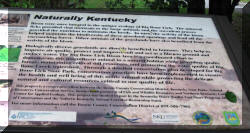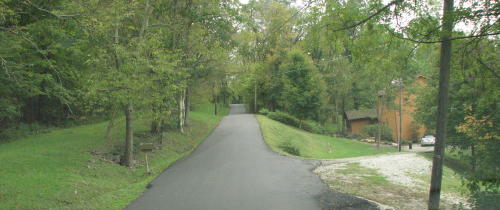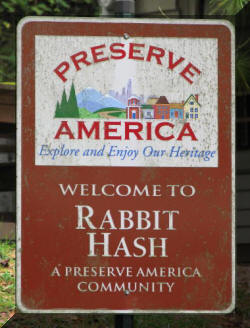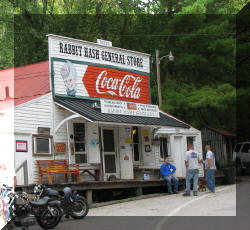Big Bone Lick State Park, Kentucky - 2011
And, Rabbit Hash National Register District
Updated: 10/16/11
Big Bone Lick State Park Visitors Center and Diorama Bison Herd Rabbit Hash
We pass signs directing us to Big Bone Lick State Park on the way to our son's home. Many times Mary Lou said, "we have to go there". We had a couple days to kill, so September, 2011 was the time to do it.
The
state park gets its name from the Pleistocene Megafauna Fossils found there. In
other words, the extraordinarily large bones (mammoth and mastodon) found in the
swamps around the salt lick.
To quote the Kentucky State Park Guide, "Visitors can see still-active salt springs, a recreated Pleistocene marsh, 20,000-year-old fossils, or the modern-day Ice Age Descendants, a bison herd. The park offers a beautiful campground with a swimming pool, miniature golf, hiking trails and an visitors center.
We were told when we contacted the state park office that cell service and Internet connections were weak or non-existent. When we arrived at the state park, the volunteer/retired guy at the gate told us he used an AT&T air card - that gave us hope. We headed for the highest part of the campground, pointed our outside antenna toward a signal and had an Internet connection during our entire stay. Cell phone service was decent also.
We could see deer through our window.
In the evening, several deer were in the valley behind our HitchHiker.
We
enjoyed beautiful sunsets behind our HitchHiker as well.
A root cellar and cemetery are all that is left of the Steward Baker Farm. In 1969 the home was torn down to build the miniature golf course. The family fought in the Union Army during the Civil War. They thought of their slaves as treasured family members who lived in the family house.
Behind the campground office was
the 1969 miniature golf course . . . it was still in operation.
Next to the combination campground office and store was the root cellar.
The Baker Family cemetery was also behind the campground office/store.
The visitors center was open and run by staff members. (The Nature Center has been closed for a couple years due to a shortage of reliable volunteers.)
Big Bone Lick State Park is considered the birthplace of American Vertebrae Paleontology. Scientists speculate that many prehistoric mammals that had not previously been found in Kentucky were driven slowly southward by the huge sheets of ice. The Ice Age (Pleistocene) started 1.8 million years ago and ended 10,000 years ago.
The gigantic mastodon, weighing from 9,000 to 11,000 lbs came to the Big Bone Lick springs to quench their thirst and satisfy their need for salt and minerals. The weight of the beasts was too much for the unstable "jelly ground" to support. When the mastodon struggled in the ooze, it only sank deeper in the swamp. The gigantic animals eventually became completely buried in the ooze, its bones preserved in the ancient prehistoric layer of the swamp. Like the mastodon, the bones of may other Ice Age mammals have been found at Big Bone Lick.
Throughout the mid 1700's vast quantities of bones were collected from the area and transported to museums throughout the world. Benjamin Franklin and Thomas Jefferson were among the scientists who studied the bones. In 1807, Captain William Clark was commissioned by President Thomas Jefferson to excavate bones from Big Bone Lick for scientific study. This made Big Bone Lick the first official paleontological collection site in North America.
This plaque was located outside the visitors center.
 In
the fall of 1755, Mary Ingles, a pioneer women who was a captive of Shawnee
Indians and French troops, was taken to Big Bone Lick on a salt-making
expedition. During her captivity she carefully planned an escape. In
preparation, she reportedly obtained a tomahawk from one of the Frenchmen in the
salt making party. Mary's escape was successful; she followed a buffalo trace to
the Ohio River, then made her way upstream and overland until she reached
Virginia.
In
the fall of 1755, Mary Ingles, a pioneer women who was a captive of Shawnee
Indians and French troops, was taken to Big Bone Lick on a salt-making
expedition. During her captivity she carefully planned an escape. In
preparation, she reportedly obtained a tomahawk from one of the Frenchmen in the
salt making party. Mary's escape was successful; she followed a buffalo trace to
the Ohio River, then made her way upstream and overland until she reached
Virginia.
The visitors center included a large mural and many displays and panels.

Mastodon jaw bone . . .
Specimens were displayed along with panels explaining the displays.
Behind the Visitors Center, you walk on an elevated wood platform around there sides of a diorama. The diorama shows a re-creation of prehistoric mammals coming to the swamp for the minerals and salt.
Tablets on the platform explained what we were looking at. (The images below are 'buttons'. Click on them to enlarge them to a size large enough to read.)
The trails to the bison started across the parking lot from the visitors center. The morning we were leaving Big Bone Lick State Park, it was raining. Mary Lou decided she would leave Fred in our warm, dry fifth wheel and walk the 0.2 miles on a wet path into the wet woods to view the bison. So, off she went with her camera in hand.
 The state park has a herd if 18 bison. By the end of the year they will cut
the herd in half. They will move bison to zoos and other habitat. Bison are
naturally Kentucky. (Click on the image at the right to
read the information.)
The state park has a herd if 18 bison. By the end of the year they will cut
the herd in half. They will move bison to zoos and other habitat. Bison are
naturally Kentucky. (Click on the image at the right to
read the information.)


This lichen was growing on a tree along the path.
This
Native American offering in celebration of the birth of this season's bison is
placed on the fence to protect it from visitors. The bags containing tobacco,
seeds and corn were place here during August and September. They will be removed
in January by the tribe's Princess and burned in a special ceremony.

This fence is where the Native Americans would prefer to place their
offerings. But in past years, visitors to the park have removed them as
souvenirs or scattered the contents on the ground when placed here.
The
road is a service road for access to the bison. The herd is fed here each
morning, then they slowly move away, grazing as they go.
If you visit this park, be sure to pick up the green brochure titled Big Bone Lick State Park, Birthplace of American Vertebrae Paleontology at the Visitors Center. There is a lot of very interesting information contained in the brochure.
Rabbit Hash was only
nine miles from the state park.
Crossing a tributary of the Ohio River, we observed a boathouse.
 Part
of the ride to Rabbit Hash was on a one lane road.
Part
of the ride to Rabbit Hash was on a one lane road.
As we approached Rabbit Hash we saw a mixture of styles of homes.
Rabbit Hash is unincorporated and therefore without fixed boundaries, which makes its exact population a matter of opinion. The population is generally regarded as between four and 40 depending on how the boundaries are drawn. There is a distinction made between urban Rabbit Hash and suburban Rabbit Hash.

 A
'Preserve America' sign welcomed us to Rabbit Hash. The name may derive from the
historic use of the local rabbit population as food. During the early 19th
century the town was well know for a rabbit hash meal.
A
'Preserve America' sign welcomed us to Rabbit Hash. The name may derive from the
historic use of the local rabbit population as food. During the early 19th
century the town was well know for a rabbit hash meal.
As you entered town, caution - pig crossing . . .
The Rabbit Hash Historical District was added to the National Register of Historic Places on December 4, 2003. It includes 330 acres, 12 buildings, 6 structures and 3 objects.
A variety of signs told the history of Rabbit Hash.
 The Piatt family established a ferry in Rabbit Hash in the early 19th century
going across the Ohio River to Indiana. The
ferry office still stands as a reminder of the importance
of the relationship with Rising Sun across the river in Indiana.
The Piatt family established a ferry in Rabbit Hash in the early 19th century
going across the Ohio River to Indiana. The
ferry office still stands as a reminder of the importance
of the relationship with Rising Sun across the river in Indiana.
This was a multi-function building.

 The
hamlet's most notable building, the Rabbit Hash General Store, is regarded as
the best know and best preserved country store in Kentucky.
The
hamlet's most notable building, the Rabbit Hash General Store, is regarded as
the best know and best preserved country store in Kentucky.
The rear of the general store was perched on stilts.
The store has been listed in the National Register of Historic Places since February 2, 1989.
The general store was loaded with antiques for sale . . . and . . . some groceries.
A
side room included a Charles Chips' can. Fred remembers his mother buying
Charles Chips.
It was a good thing the sign
to the 'Complaint Department
warned you to
watch your step.
It was a ten foot drop.
The
restrooms next to the general store were also built on the side of the
hill. The floor inside did not go wall to wall giving an uneasy feeling.
The Mercantile Store across the road also had some interesting items for sale.
An
interesting use for an old wringer washer . . .
Rabbit Hash is a small town but it has an active mayor. She was out in the street greeting visitors. In 1998, a dog names Goofy was elected mayor in an unofficial "election". In 2004, another dog named Junior was elected mayor. Junior later came under scrutiny by the Northern Kentucky Health Department and was banned from entering the General Store in the town due to complaints. Junior died in May, 2008. A new election was held. Lucy Lou, a border collie was elected mayor.
Rabbit Hash also includes a trailer park on the river's edge. This yellow car passed us as we photographed the trailer park.
A ride to Rabbit Hash was an enjoyable way to spend the afternoon.
We had a good time at Big Bone Lick State Park and area. The campground was not busy in the middle of the week. However, we understand it is a busy park on weekends.